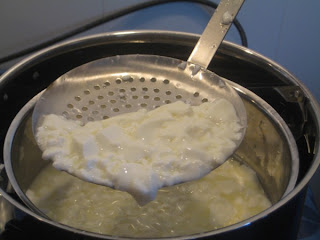Summer's such a great time for salads. They're an ideal way to use a variety of produce, and if you make big batches, they make for an easy lunch or supper without having to turn on the stove.
These are two recipes I made for the first time this year. Both are tasty, and both have made repeat turns in my kitchen over the last few weeks. And not surprisingly, both come courtesy of Jaime Oliver.
First up is a great pasta salad. The basic recipe is fantastic, but I modified it a little to add some protein in the form of beans and lentils. This makes a quick lunch for a number of days running.
One fun thing about this salad is the dressing. While the pasta's cooking (and the lentils in my case), you add in three cloves of garlic into the water during the last few minutes. This softens the garlic a little, so you can mash it up in your mortar and pestle to serve as a base for your dressing. It's fun to do and gets out some aggressions along the way.
With the dressing out of the way, next up is the chopping. It takes a little time, so make sure you have a good podcast on in the background (my latest faves are Here's the Thing, with Alec Baldwin and WTF with Marc Maron).
This last photo is particularly terrible, but the lighting wasn't cooperating with me for the shoot. Trust me that the final product is prettier than this.
And here's an only slightly better shot of the other salad, a great combination of beet and green apple. Toss in a little mint or basil, dress lightly with lime juice, olive oil and some salt and pepper, and you've got yourself a winner. This one was a hit with my niece recently, especially after I told her eating it would turn her pee pink.
Best Pasta Salad
adapted from
jamieoliver.com and itaintmeatbabe.com
1 cup dried lentils (I like lentils du puy)
1/2 cup cooked or canned
black beans (or beans of your choice)
11 oz small shells pasta
3 fairly small cloves of
garlic still in their skins
1 1/2 cups yellow cherry tomatoes, quartered
1
1/2 cups red cherry tomatoes, quartered
1/2 an english cucumber,
chopped, or several Lebanese cukes
1/4 cup pitted black olives, chopped
2 tbsp fresh
chives, chopped
1/4 cup lightly packed fresh basil, chopped
4 tbsp white
wine vinegar
7 tbsp olive oil
salt and pepper to taste
Boil 3 cups
of lightly salted water and add the dry lentils. Cook until they are tender,
approximately 15 minutes. Drain and set aside.
In a larger pot of salted
water, boil pasta and whole cloves of garlic until the pasta is al dente,
approximately 5 minutes. Drain pasta and set garlic aside to cool. You want your
garlic to be smushy. If you can't squeeze it out of its skin, then you'll need
to boil it for a little longer.
Combine tomatoes, cucumber, herbs, and
olives in a large bowl and add cooled pasta and lentils. Uniformity is crucial
to make this salad work well, so ensure that all your vegetables are chopped to
similar sizes. Using the size of the pieces of pasta is a good guide.
Using a mortar and pestle or some other kind of mashing apparatus, smush the
boiled garlic into a paste. Then add vinegar and olive oil. You can season this
dressing with salt and pepper if you are feeling brave, or you can wait until
the whole salad is mixed and season it to taste then.
Mix the dressing in
with all the other ingredients. Season accordingly and chill in the fridge for
half an hour or so before serving.
Jamie says the salad serves four, but this makes a LOT, so I would guess it would serve six or so as main and many more as a side dish.
Beet and apple salad
Adapted from
Jaime Magazine
There's a full recipe for this in a recent issue of Jamie's magazine that also calls for the inclusion of red cabbage. I left out the cabbage and it's still pretty great. This is my rendition of the salad from memory, but it's incredibly adaptable.
2 beets, raw, peeled and/or scrubbed
*up quantities if you need to make more
1-2 Granny Smith apples, depending on your preference
handful of mint leaves or basil leaves finely chopped
juice of half-whole lime
drizzle of olive oil
salt and pepper to taste
Scrub your beets and remove root and topper. Depending on how clean they are, and how thick the skin is, you may choose to peel these. Slice them up and cut into matchstick pieces. If you'd rather grate these in the food processor, or by hand, feel free.
Do the same with the apples, minus the peeling step. Drop into a bowl, and scatter over your mint or basil leaves (or you could use a combination). Drizzle over the oil to taste, the lime and seasoning. Mix together with your fingers, which will no doubt be stained pink from your beet chopping.
The apples soon turn pink on account of the beets, but that's part of the charm. This is very good at room temperature, but even better cold from the fridge.

















































